Forecasting Underground Water Dynamics within the Technogenic Environment of a Mine Field. Case Study
Abstract
:1. Introduction
- –
- The substantiation of a scheme of a geofiltration numerical model of a mine field, taking into consideration both natural and technogenic factors of underground water mode formation;
- –
- The identification of basic factors forming water ingress in a mine as well as the regularities of the transformation of filtration parameters of the disturbed rock mass;
- –
- The determination of the influence of the mine working flooding on the ecological state of the neighboring territories and substantiation of engineering measures of water control.
2. Methodology
- –
- Systemization of data of mining and geological conditions;
- –
- The model identification in terms of the physical and dynamical analogy of the object;
- –
- Forecasting solutions (generally, integrity of the latter is identified by means of the schematization quality of the conditions as well as the model verification).
2.1. Analysis of Natural and Technogenic Conditions, and Substantiation of Hydrodynamic Scheme of a Mine Field Model
2.2. Identification of the Model
3. Results and Discussion
- If natural water conductivity of coal seams is 0.5–1.5 m2/day, then actual water inflow values may be achieved when transit zones of hyperpermeability are available. Within a mine field, they are represented by means of sandstone formations with up to 50–60 m thickness and up to 30 m2/day water conductivity. The sandstone occurs in the coal seam roof and outcrops under the watered overburden deposits. According to lithological and facial analysis, it is alluvial sandstone of the Early Carboniferous paleochannels; regularities of its spreading over the area correspond to the heightened water ingress during mining.
- A total of 70% of the water inflow into a mine are provided from Meso-Cenozoic deposits; 30% are the capacity reserves of carbonous formation. As a result, the formation of a conical depression up to 30 m takes place within the Bucha-Kyiv aquifer as well as changes in directions of filtration flows in the neighborhood of the Samara River. Under the disturbed conditions, the river stops being a drainage zone transforming into a feeding zone for overburden deposits. Thus, it becomes an extra source for water mine workings.
- Movement of the conical depression within the Bucha level performs synchronously by putting into operation a new coal seam toward a zone of outcrop under overburden deposits.
- Maximum involvement of the Samara River flow in the mine drainage was recorded while extracting the C5 seam within the river plain flood (i.e., at a 200 m distance from its bed) and while approaching safe mining boundaries. Hence, a maximum of 69% (i.e., 570 m3/h) of the water inflow within the seam depends upon the river water leakage. The index drops down to 17% if the mining distances from the coal seam outcrop under the Bucha-Kyiv deposits and the thickness of the underflow decreases within the eastern part of the mine filed.
- A value of the water inflow into a mine cannot correlate with the increased mining area. Within the area mined out with the roof caving, carbonous formation thickness is a time-variable value which increases 10–15 times in the process of rock displacement. The value decreases after 5–10 years and stops performing a drainage function after 15–20 years (Figure 12). It is possible to determine such transformations for the specific mining and geological conditions while solving long-term (i.e., during 15–20 years) time series of non-stationary identification problems, being a mandatory stage for the methods developing adequate models of mine fields, and obtaining durable, high-integrity forecasts.
- Variant 1. Complete mine flooding.
- 2.
- Variant 2. Mine flooding with preservation of the available underground system of the main mine drainage.
- 3.
- Variant 3. The mine abandonment with drainage mode support and by-pit equipping with submersible pumps.
- –
- +10 m with 350 m3/h down to 300 m3/h discharge;
- –
- −10 m with 350 m3/h down to 300 m3/h drainage discharge;
- –
- −30 m with 350 m3/h down to 300 m3/h discharge.
- 4.
- Variant 4. Alternative to protect the plain flood against waterlogging by means of water storage facility construction within the productive strata of paleochannel sandstone being of heightened hydraulic conductivity.
4. Conclusions
Author Contributions
Funding
Institutional Review Board Statement
Informed Consent Statement
Data Availability Statement
Acknowledgments
Conflicts of Interest
References
- Anpilova, Y.; Yakovliev, Y.; Drozdovych, I. Landscape and geological factors of water and ecological conditions technogenesis of donbas at the post-mining stage. In Proceedings of the Geoinformatics: Theoretical and Applied Aspects, Kyiv, Ukraine, 11–14 May 2010; pp. 1–5. [Google Scholar]
- Timoshuk, V.; Demchenko, J.; Sherstuk, Y. The role of natural and technogenic components in failure of geomechanical stability of the territories which are in the influence zone of mining objects. New Tech. Technol. Min. 2010, 189–192. [Google Scholar] [CrossRef]
- Lozynskyi, V.; Medianyk, V.; Saik, P.; Rysbekov, K.; Demydov, M. Multivariance solutions for designing new levels of coal mines. Rudarsko-Geološko-Naftni Zbornik 2020, 35, 23–32. [Google Scholar] [CrossRef]
- Malvić, T.; Ivšinović, J.; Velić, J.; Sremac, J.; Barudžija, U. Increasing Efficiency of Field Water re-injection during water-flooding in mature hydrocarbon reservoirs: A Case study from the Sava depression, Northern Croatia. Sustainability 2020, 12, 786. [Google Scholar] [CrossRef] [Green Version]
- Popovych, V.; Stepova, K.; Voloshchyshyn, A.; Bosak, P. Physico-Chemical Properties of Soils in Lviv Volyn Coal Basin. In Proceedings of the IVth International Innovative Mining Symposium, Kemerovo, Russia, 14–16 October 2019. [Google Scholar]
- Gorova, A.; Pavlychenko, A.; Borysovs’ka, O. The study of ecological state of waste disposal areas of energy and mining companies. Min. Miner. Depos. 2013, 169–172. [Google Scholar] [CrossRef]
- Buzylo, V.; Pavlychenko, A.; Savelieva, T.; Borysovska, O. Ecological aspects of managing the stressed-deformed state of the mountain massif during the development of multiple coal layers. E3S Web Conf. 2018, 60, 00013. [Google Scholar] [CrossRef] [Green Version]
- Keqiang, H.; Zhiliang, W.; Xiaoyun, M.; Zengtao, L. Research on the displacement response ratio of groundwater dynamic augment and its application in evaluation of the slope stability. Environ. Earth Sci. 2015, 74, 5773–5791. [Google Scholar] [CrossRef]
- Bentabet, A.; Azzaz, H.; Emblanch, C.; Benamina, B. The impact of agricultural development on karstic groundwater of the Saïda mountains, Algeria. Rudarsko-Geološko-Naftni Zbornik 2019, 34, 97–105. [Google Scholar] [CrossRef]
- Saba, T.; Illangasekare, T.H. Effect of groundwater flow dimensionality on mass transfer from entrapped nonaqueous phase liquid contaminants. Water Resour. Res. 2000, 36, 971–979. [Google Scholar] [CrossRef]
- Kovač, Z.; Nakić, Z.; Barešić, J.; Parlov, J. Nitrate origin in the Zagreb aquifer system. Geofluids 2018, 1–15. [Google Scholar] [CrossRef] [Green Version]
- Culver, T.B.; Hallisey, S.P.; Sahoo, D.; Deitsch, J.J.; Smith, J.A. Modeling the desorption of organic contaminants from long-term contaminated soil using distributed mass transfer rates. Environ. Sci. Technol. 1997, 31, 1581–1588. [Google Scholar] [CrossRef]
- Huljek, L.; Perković, D.; Kovač, Z. Nitrate contamination risk of the Zagreb aquifer. J. Maps 2019, 15, 570–577. [Google Scholar] [CrossRef] [Green Version]
- Tikhonov, V.; Karaeva, T.; Ushakova, E. The geosystem basis environmental of safe disposal of the objects of mining complex. In Proceedings of the International Multidisciplinary Scientific GeoConference SGEM2014, Science and Technologies in Geology, Exploration and Mining, Albena, Bulgaria, 19–25 June 2014. [Google Scholar] [CrossRef]
- Li, X.; Li, S.; Chen, J.; Liao, Q. Coupling effect mechanism of endogenic and exogenic geological processes of geological hazards evolution. Chin. J. Rock Mech. Eng. 2008, 27, 1792–1806. [Google Scholar]
- Popovych, V.; Stepova, K.; Prydatko, O. Environmental hazard of Novoyavorivsk municipal landfill. MATEC Web Conf. 2018, 247, 00025. [Google Scholar] [CrossRef] [Green Version]
- Sdfbg Nathoo, J.; Gay, E.H.; Hussain, N. Development of a predictive model to determine the temporal variability in mine feed water quality towards informing and forecasting plant operating strategy—A South African coal mine water treatment plant case study. Water Pract. Technol. 2016, 11, 621–633. [Google Scholar] [CrossRef]
- Fan, G.; Zhang, S.; Zhang, D.; Zhang, C.; Chen, M.; Li, Q. An index of aquiclude destabilization for mining-induced roof water inrush forecasting: A case study. Water 2019, 11, 2170. [Google Scholar] [CrossRef] [Green Version]
- Nakić, Z.; Mileusnić, M.; Pavlić, K.; Kovač, Z. Environmental geology and hydrology. Phys. Sci. Rev. 2017, 2, 20160119. [Google Scholar] [CrossRef]
- Dfbg Kang, J.; Hu, Y. Forecasting and preventing of water calamity in underground engineering of mine. J. Liaoning Tech. Univ. Nat. Sci. Ed. 2001, 20, 758. [Google Scholar]
- Liu, X.; Wang, S. Mine water inrush forecasting during the mining under waters. Disaster Adv. 2012, 5, 877–882. [Google Scholar]
- Dychkovskyi, R.; Shavarskyi, I.; Saik, P.; Lozynskyi, V.; Falshtynskyi, V.; Cabana, E. Research into stress-strain state of the rock mass condition in the process of the operation of double-unit longwalls. Min. Miner. Depos. 2020, 14, 85–94. [Google Scholar] [CrossRef]
- Khomenko, O.; Barna, T. Zonal-and-wave structure of open systems on micro, mega- and macrolevels of the universe. Philos. Cosmol. 2019, 22, 24–32. [Google Scholar] [CrossRef] [PubMed]
- Vladyko, O.; Kononenko, M.; Khomenko, O. Imitating modeling stability of mine workings. Geomech. Process. Undergr. Min. 2012, 147–150. [Google Scholar] [CrossRef]
- Abdiev, A.; Mambetova, R.; Abdiev, A.; Abdiev, S. Studying a correlation between characteristics of rock and their conditions. Min. Miner. Depos. 2020, 14, 87–100. [Google Scholar] [CrossRef]
- Malanchuk, Z.; Malanchuk, Y.; Korniyenko, V.; Ignatyuk, I. Examining features of the process of heavy metals distribution in technogenic placers at hydraulic mining. East. Eur. J. Enterp. Technol. 2017, 85, 45–51. [Google Scholar] [CrossRef] [Green Version]
- Malanchuk, Y.; Korniienko, V.; Moshynskyi, V.; Soroka, V.; Khrystyuk, A.; Malanchuk, Z. Regularities of hydromechanical amber extraction from sandy deposits. Min. Miner. Depos. 2019, 13, 49–57. [Google Scholar] [CrossRef]
- Ursul, A.; Ursul, T. Environmental education for sustainable development. Future Hum. Image 2018, 9, 115–125. [Google Scholar] [CrossRef]
- Dubrova, N.A. Evaluating changes in filtration properties of deformable rock mass resulting from the repeated undeworking. Visnyk Krnu 2014, 1, 96–106. [Google Scholar]
- Podvigina, O.O. On the changes in hydrogeological situation under the conditions of mine flooding in the Central Donbas part based upon modelling. Collect. Sci. Pap. UkrGPI 2007, 1, 92–98. [Google Scholar]
- Chetveryk, M.S.; Androshchuk, Y.V. Theory of Rock Mass Displacement and Deformational Process Control in the Context of Underground Coal Mining; RIA Dnepr-VAL: Dnipropetrovsk, Ukraine, 2004; p. 148. [Google Scholar]
- Rudakov, D.V.; Ivanova, Y.S. Geomechanical assessment of the fissured rock permeability around underground mine workings. Naukovyi Visnyk Natsionalnoho Hirnychoho Universytetu 2012, 2, 49–53. [Google Scholar]
- Yelchaninov, Y.A.; Golovko, I.V. Formation of secondary underground aquifers after abandonment of mines. Gorn. Inf. Anal. Byulleten 2007, 8, 147–152. [Google Scholar]
- Perkova, T.I.; Rudakov, D.V. Study of leaching in fractured rocks affected by mineralized mine water. Naukovyi Visnyk Natsionalnoho Hirnychoho Universytetu 2014, 5, 5–10. [Google Scholar]
- Sadovenko, I.; Inkin, O.; Zagrytsenko, A. Theoretical and geotechnological fundamentals for the development of natural and man-made resources of coal deposits. Min. Miner. Depos. 2016, 10, 1–10. [Google Scholar] [CrossRef] [Green Version]
- Rudakov, D.; Inkin, O.; Dereviahina, N.; Sotskov, V. Effectiveness evaluation for geothermal heat recovery in closed mines of Donbas. E3S Web Conf. 2020, 201, 01008. [Google Scholar] [CrossRef]
- Mendygaliyev, A.; Arshamov, Y.; Selezneva, V.; Yazikov, E.; Bekbotayeva, A. Prospects for application of multi-spectral earth sensing data in forecasting and searching for reser-voir-infiltration uranium deposits. News Natl. Acad. Sci. Repub. Kazakhstan 2021, 446, 90–97. [Google Scholar] [CrossRef]
- Khalymendyk, I.; Baryshnikov, A. The mechanism of roadway deformation in conditions of laminated rocks. J. Sustain. Min. 2018, 17, 41–47. [Google Scholar] [CrossRef]
- Babets, D.V.; Sdvyzhkova, O.O.; Larionov, M.H.; Tereshchuk, R.M. Estimation of rock mass stability based on probability approach and rating systems. Naukovyi Visnyk Natsionalnoho Hirnychoho Universytetu 2017, 2, 58–64. [Google Scholar]
- Shashenko, A.; Gapieiev, S.; Solodyankin, A. Numerical simulation of the elastic-plastic state of rock mass around horizontal workings. Arch. Min. Sci. 2009, 54, 341–348. [Google Scholar]
- Sadovenko, I.; Ulytsky, O.; Zahrytsenko, A.; Boiko, K. Risk assessment of radionuclide contamination spreading while flooding coal mined-out rocks. Min. Miner. Depos. 2020, 14, 130–136. [Google Scholar] [CrossRef]
- Sadovenko, I.; Rudakov, D.; Podvigina, O. Analysis of hydrogeodynamics in a mining region during exploitation till closure of coal mines. New Tech. Technol. Min. Sch. Undergr. Min. 2010, 61–69. [Google Scholar] [CrossRef]
- Purgina, D.; Kuzevanov, K.; Burmakova, E. Hydrogeological conditions of potable water supply the Kuznetsk Coal Basin, Russia. E3S Web Conf. 2019, 98, 09024. [Google Scholar] [CrossRef]
- Sadovenko, I.A.; Inkin, A.V.; Rudakov, D.V.; Hriplivets, J.V. Modeling of the flooding process of the mine “Novogrodovskaya No 2” to assess the possibility of using its heat source. Izv. Ural. Gos. Gorn. Univ. 2014, 33, 29–37. [Google Scholar]
- Armenat, M.; Malek, K. The underground world heritage site in the harz mining region. Z. Geomorphol. 2021, 62, 265–281. [Google Scholar] [CrossRef]
- Luo, A.K.; Hou, Y.; Hu, X.Y. Mining influence on underground water resources in arid and semiarid regions. In IOP Conference Series: Earth and Environmental Science; IOP Publishing: Bristol, UK, 2018. [Google Scholar] [CrossRef]
- Lyashenko, V.I.; Golik, V.I.; Dyatchin, V.Z. Increasing environmental safety by reducing technogenic load in mining regions. Izv. Ferr. Metall. 2020, 63, 529–538. [Google Scholar] [CrossRef]
- Scheidler, S.; Huggenberger, P.; Dresmann, H.; Auckenthaler, A.; Epting, J. Regional groundwater flow and karst evolution–theoretical approach and example from Switzerland. Environ. Earth Sci. 2021, 80, 201. [Google Scholar] [CrossRef]
- Kirin, R. Statutory and regulatory requirements in the process of mineral mining in Ukraine. Review and analysis. Min. Miner. Depos. 2019, 13, 59–65. [Google Scholar] [CrossRef] [Green Version]
- Bazaluk, O.; Petlovanyi, M.; Lozynskyi, V.; Zubko, S.; Sai, K.; Saik, P. Sustainable underground iron ore mining in Ukraine with backfilling worked-out area. Sustainability 2021, 13, 834. [Google Scholar] [CrossRef]
- Ursul, A.; Tirdea, T.; Ursul, T. Limits to Growth and Achievement of Global Sustainability. Philos. Cosmol. 2018, 21, 42–51. [Google Scholar] [CrossRef]
- Haiko, H.; Saik, P.; Lozynskyi, V. The philosophy of mining: Historical aspect and future prospect. Philos. Cosmol. 2019, 22, 76–90. [Google Scholar] [CrossRef]
- Popovych, V.; Telak, J.; Telak, O.; Malovanyy, M.; Yakovchuk, R.; Popovych, N. Migration of Hazardous Components of Municipal Landfill Leachates into the Environment. J. Ecol. Eng. 2020, 21, 52–62. [Google Scholar] [CrossRef]
- Younger, P.L.; Banwart, S.A.; Hedi, R.S. Mine Water: Hydrology, Pollution, Remediation; National Groundwater Association: Westerville, OH, USA, 2002; p. 442. [Google Scholar]
- Wolkersdorfer, C. Water Management at Abandoned Flooded Underground Mines. Fundamentals. Tracer Tests. Modelling. Water Treatment; Springer: Berlin, Germany, 2008; p. 465. [Google Scholar]
- Rybnikova, L.S.; Rybnikov, P.A. Geofiltration rock mass model within the area of operating and being liquidated mines of the folded Ural mountains. Litosfera 2013, 3, 130–136. [Google Scholar]
- Sadovenko, I.; Zagrytsenko, A.; Podvigina, O.; Dereviagina, N. Assessment of environmental and technical risks in the process of mining on the basis of numerical simulation of geofiltration. Min. Miner. Depos. 2016, 10, 37–43. [Google Scholar] [CrossRef] [Green Version]
- Petlovanyi, M.V.; Lozynskyi, V.H.; Saik, P.B.; Sai, K.S. Modern experience of low-coal seams underground mining in Ukraine. Int. J. Min. Sci. Technol. 2018, 28, 917–923. [Google Scholar] [CrossRef]
- Petlovanyi, M.; Malashkevych, D.; Sai, K.; Zubko, S. Research into balance of rocks and underground cavities formation in the coal mine flowsheet when mining thin seams. Min. Miner. Depos. 2020, 14, 66–81. [Google Scholar] [CrossRef]
- Bear, J.; Verruijt, A. Modeling Groundwater Flow and Polluyion; Springer: Berlin, Germany, 1998; p. 414. [Google Scholar]
- Kinzelbach, W. Groundwater Modeling (An Introduction with Sample Programs in BASIC); Elsevier: Amsterdam, The Netherlands, 1986. [Google Scholar]
- Zahrytsenko, A.; Podvigina, O.; Dereviahina, N. Scientific and methodological foundations to develop numerical hydrodynamical models of mine fields in Donbas. E3S Web Conf. 2018, 60, 00034. [Google Scholar] [CrossRef]
- Zelenska, L.I.; Yevhrashkina, H.P. Ekoloho-hidroheolohichni problemy terytorii, pryliahaiuchykh do khvostoskhovyshch Kryvorizkoho zalizorudnoho baseinu ta shliakhy yikh rishennia. J. Geol. Geogr. Geoecol. 2011, 19, 1. [Google Scholar]
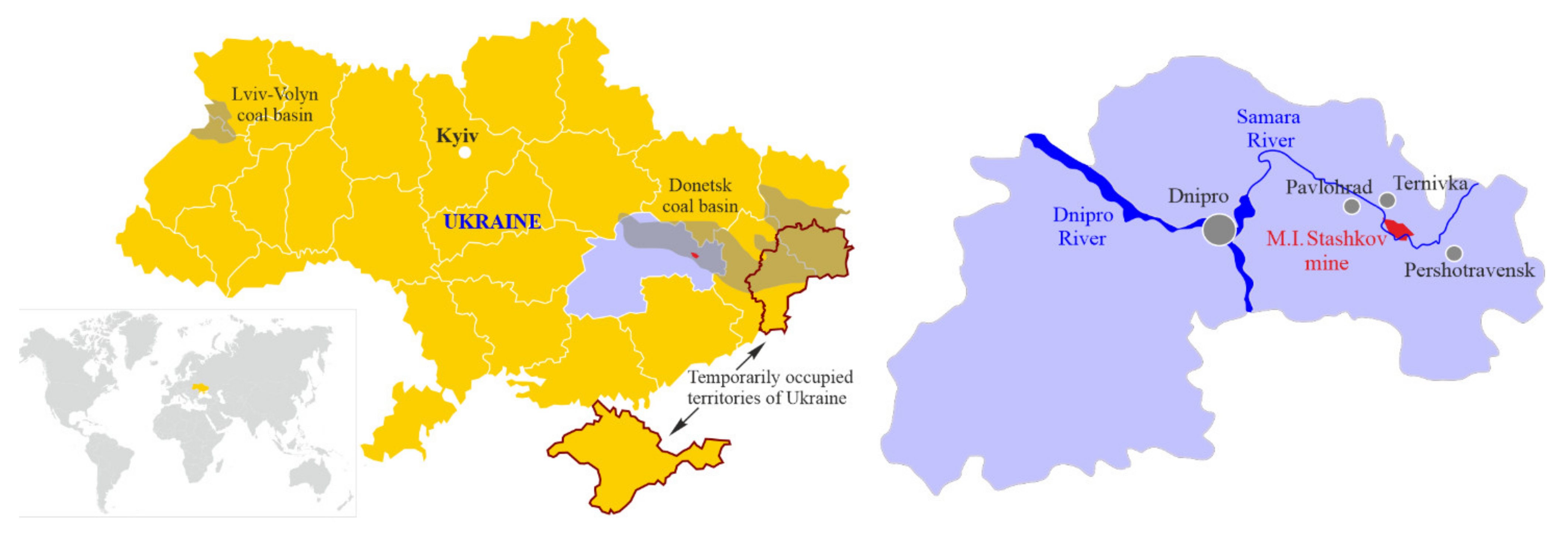
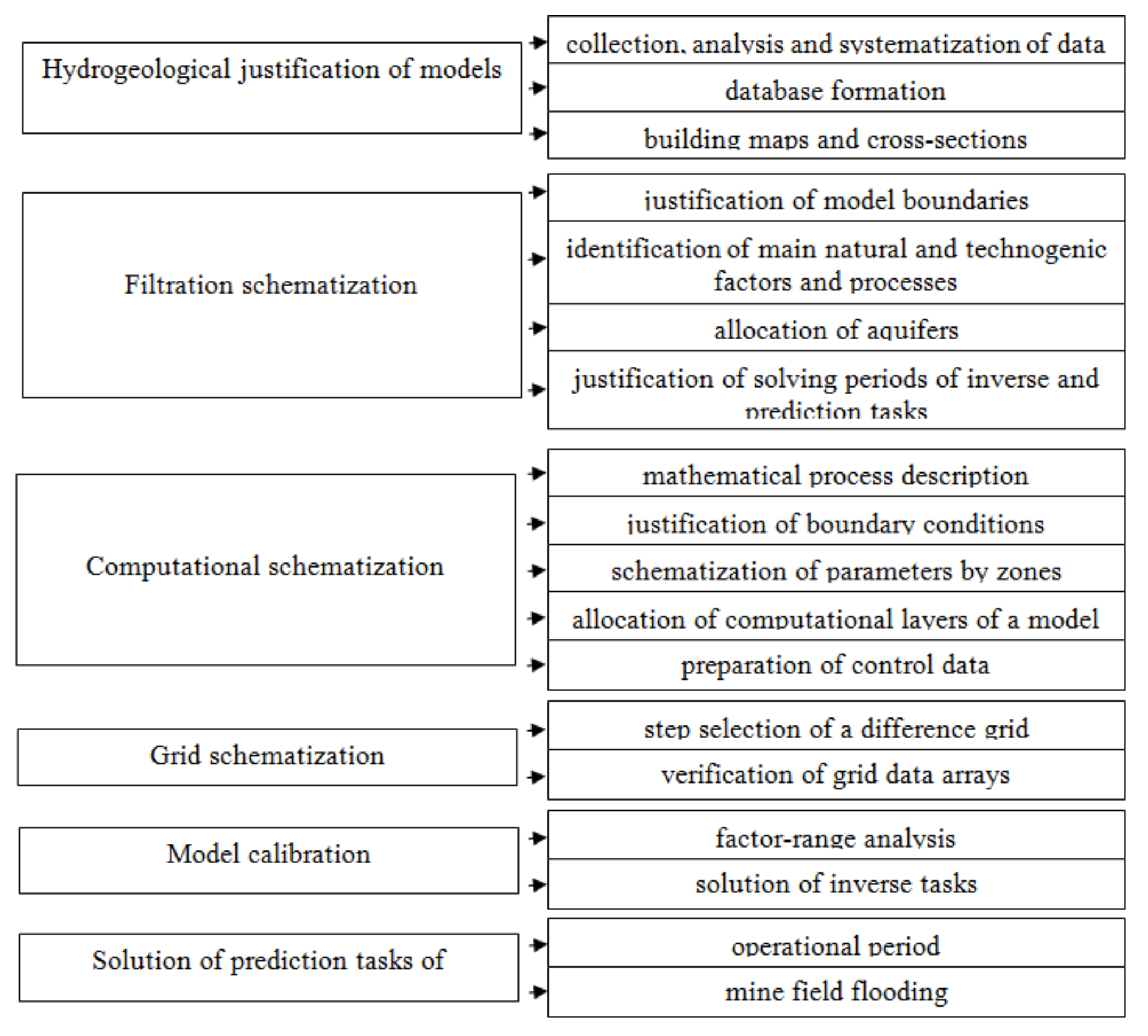
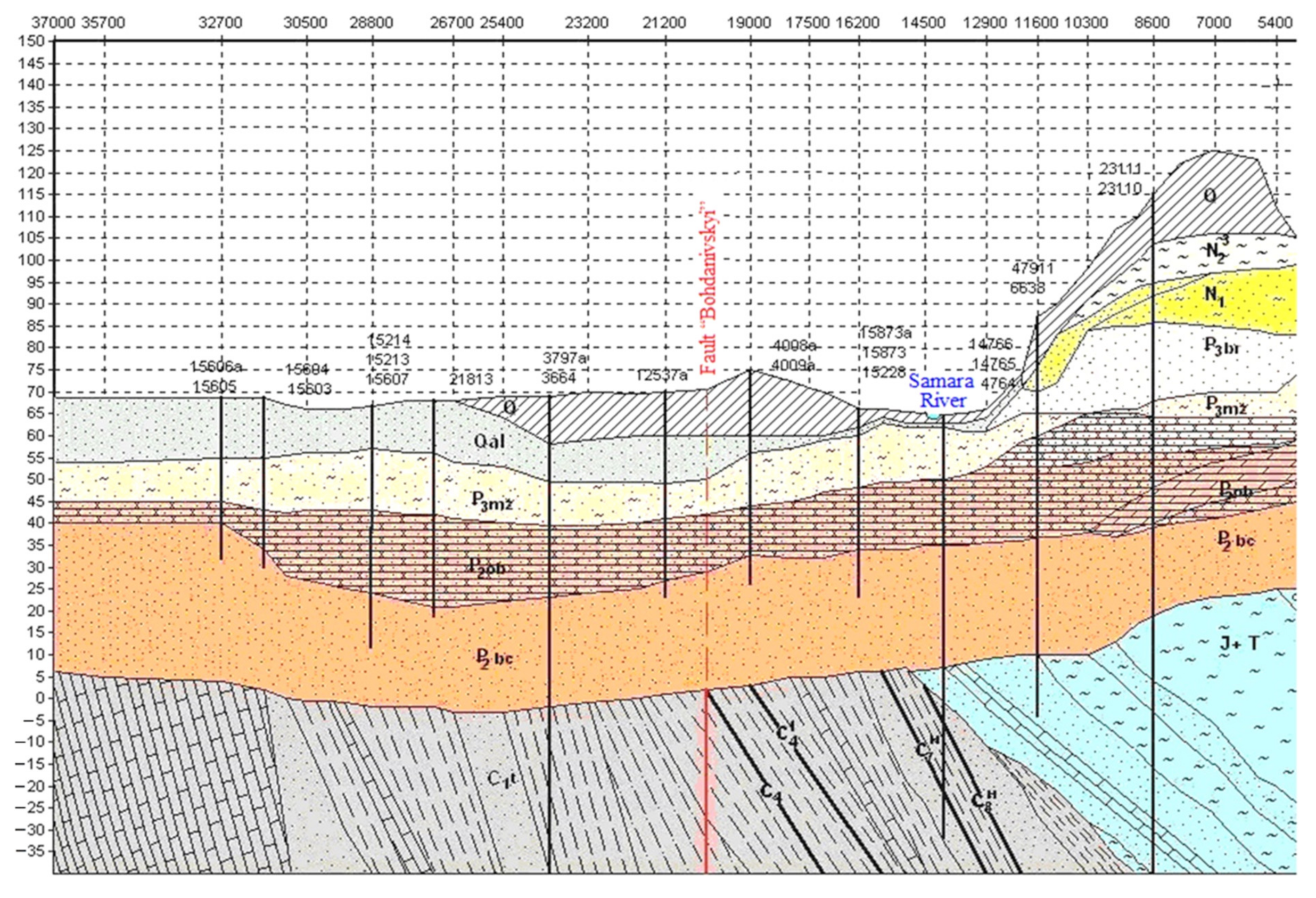


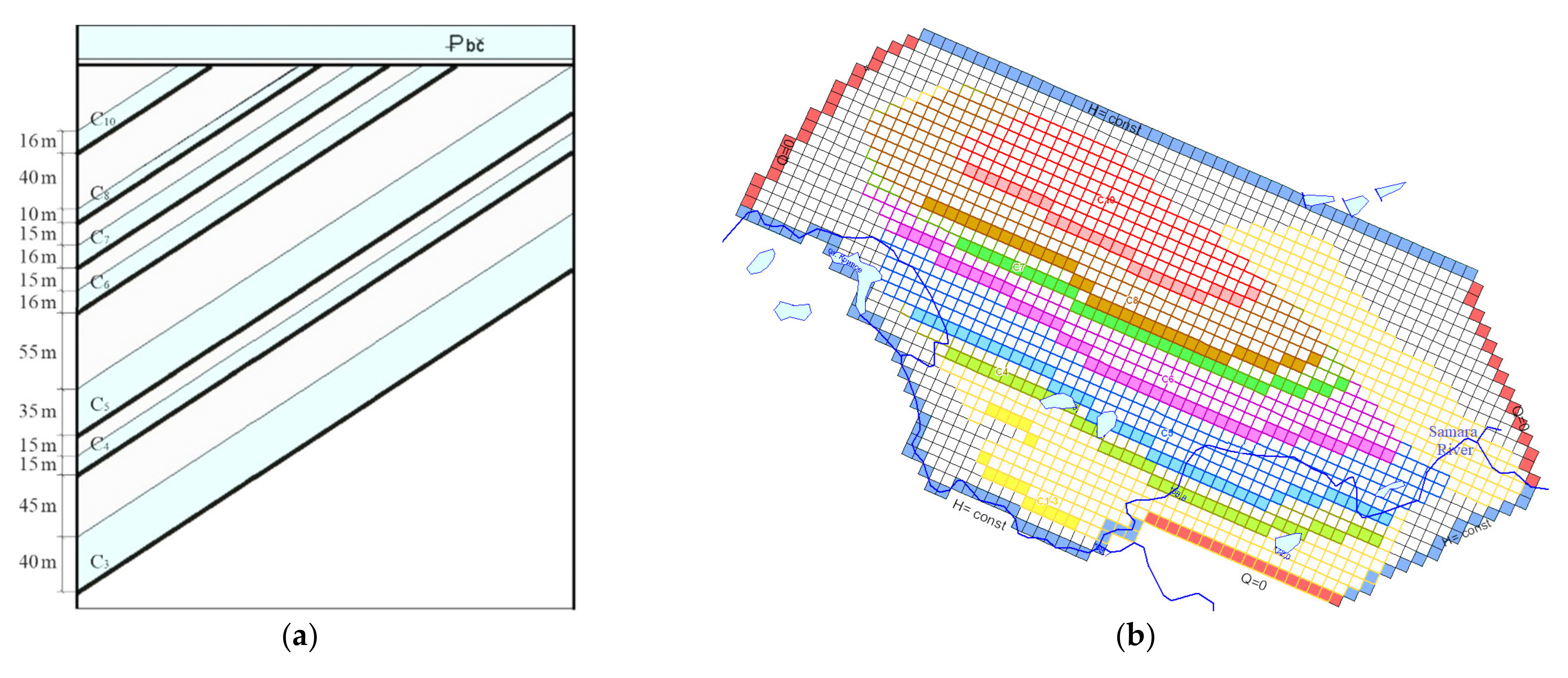
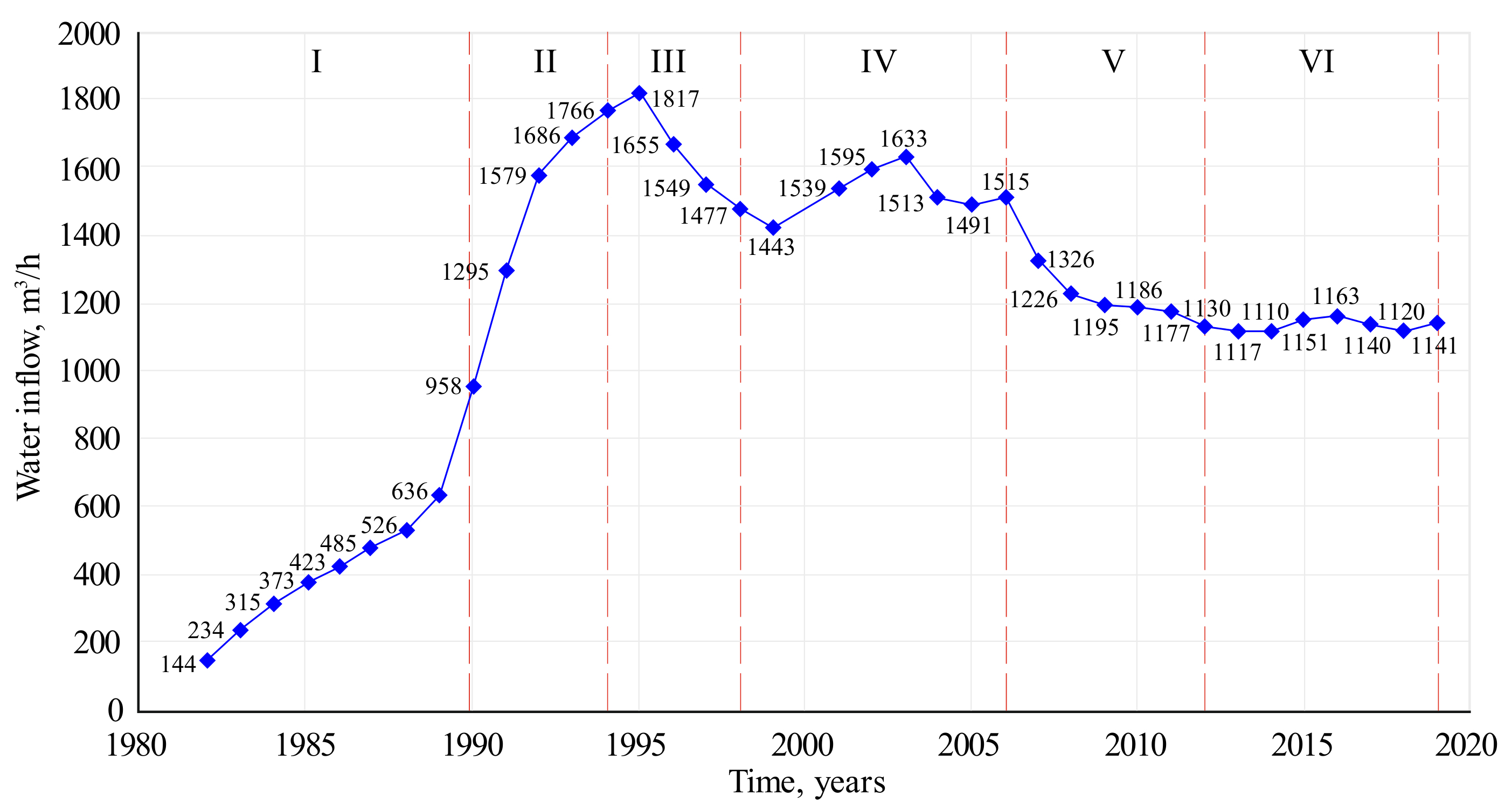



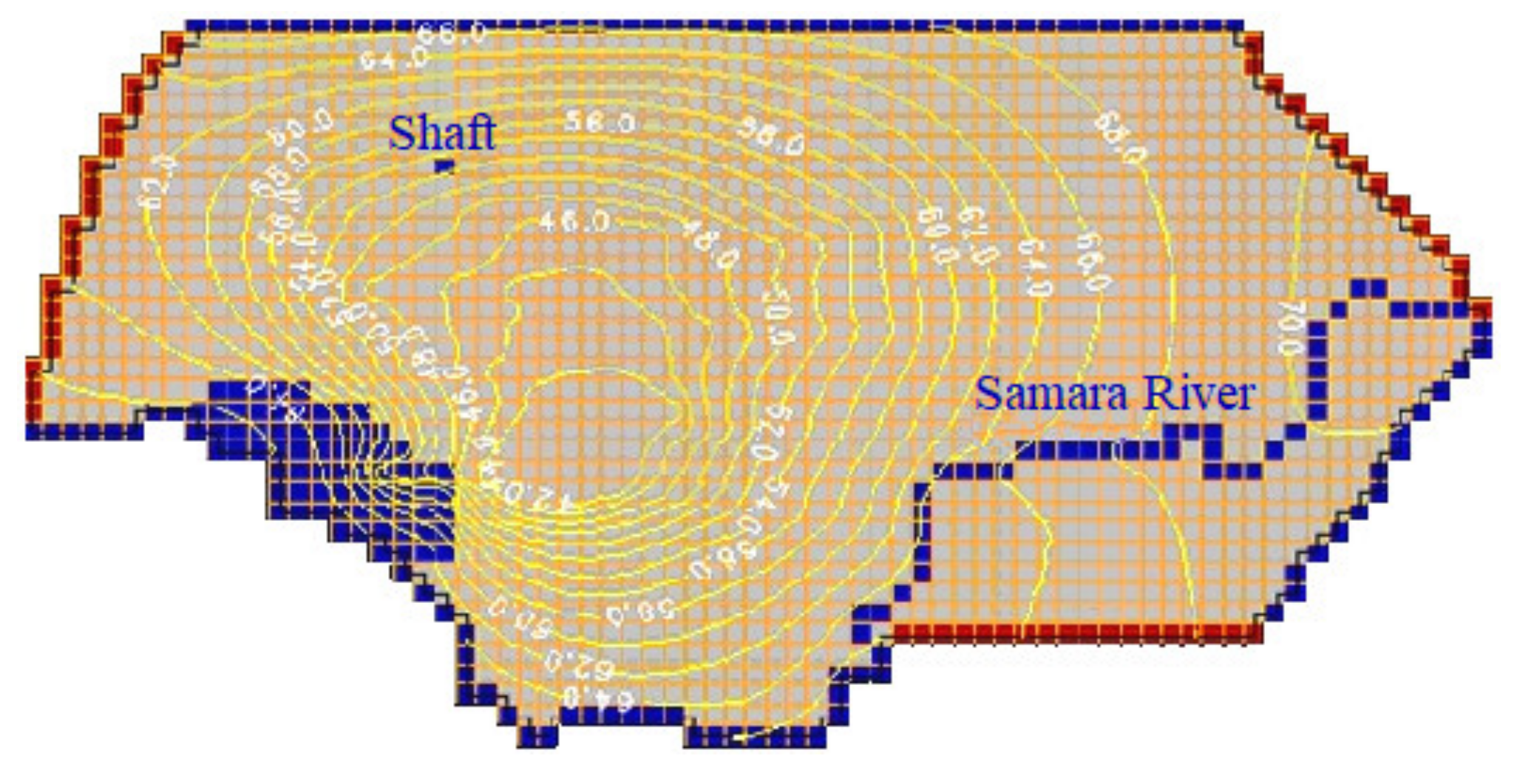
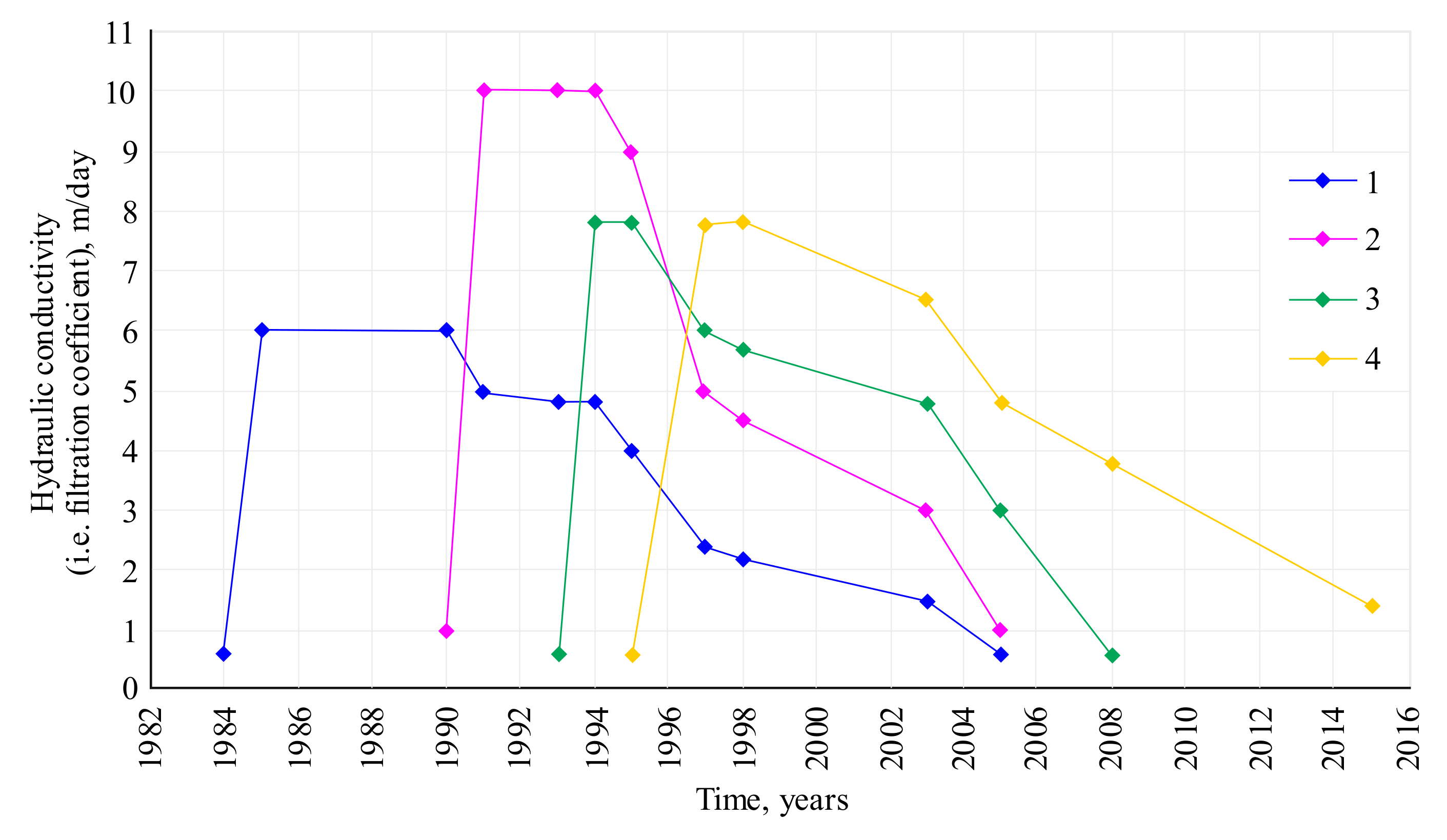

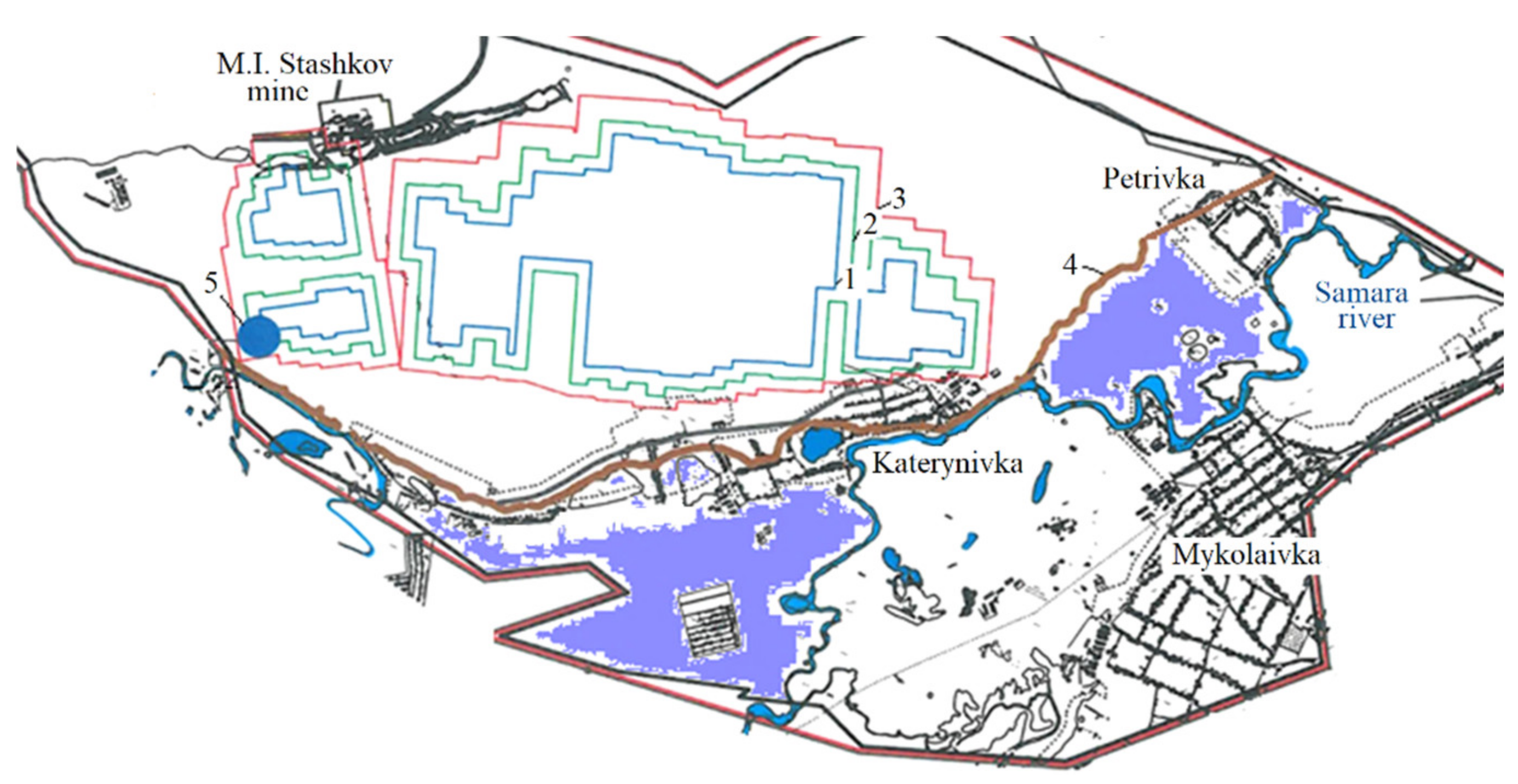
| No. | Geological Index of the Rocks | Well | Number of Analytical Blocks of the Model (x/y) | Wellhead Elevation, m | Underground Water Elevation, m (Years of 1954–1980) | |
|---|---|---|---|---|---|---|
| Object | Model | |||||
| 1 | P2 kv + bc | 3782 | 11/4 | 76.8 | 72.6 | 74.3 |
| 2 | P2 kv + bc | 3875 | 37/3 | 76.1 | 74.5 | 75.4 |
| 3 | P2 kv + bc | 13,410 | 30/30 | 73.5 | 71.6 | 69.3 |
| 4 | P2 kv + bc | 13,594 | 40/34–35 | 72.0 | 70.8 | 69.2 |
| 5 | P2 kv + bc | 3740 | 57–58/32 | 72.2 | 71.6 | 70.6 |
| 6 | P2 kv + bc | 13,591 | 54/22–23 | 71.9 | 70.9 | 70.7 |
| 7 | P2 kv + bc | 13,564 | 65/13–14 | 73.2 | 71.8 | 71.9 |
| 8 | P2 bc | 3700 | 62/20–21 | 72.7 | 70.4 | 70.9 |
| 9 | P2 bc | 14 | 48/27 | 71.8 | 70.2 | 69.7 |
| 10 | P2 bc | 3683 | 42/19 | 126.7 | 70.1 | 71.2 |
| 11 | P2 bc | 15,573 | 57/17 | 82.3 | 71.0 | 71.9 |
| 12 | P2 bc | 3756a | 14/20–21 | 74.0 | 68.5 | 68.3 |
| 13 | C1 | 3787 | 18/7 | 121.6 | 70.4 | 70.4 |
| 14 | C1 | 3849 | 29–30/15 | 135.9 | 71.5 | 70.9 |
| 15 | C1 | 1313 | 43/11 | 138.1 | 73.5 | 72.5 |
| 16 | C1 | 3681 | 43/19 | 126.8 | 70.2 | 70.2 |
| 17 | C1 | 15 | 48/26 | 71.8 | 70.6 | 70.1 |
| 18 | C1 | 3739 | 57–58/32 | 73.5 | 70.7 | 70.4 |
| 19 | C1 | 1334 | 63/20 | 72.6 | 70.9 | 71.0 |
| Expandable Components of the Balance | Water Inflow Value, m3/h |
|---|---|
| Mine working–underground water interconnection (inclusive of leakage from Bucha aquifer at the expense of filtration from the Samara River) | 822 (570) |
| Flow through the level roof | 0.9 |
| Flow through the floor | 53.7 |
Publisher’s Note: MDPI stays neutral with regard to jurisdictional claims in published maps and institutional affiliations. |
© 2021 by the authors. Licensee MDPI, Basel, Switzerland. This article is an open access article distributed under the terms and conditions of the Creative Commons Attribution (CC BY) license (https://creativecommons.org/licenses/by/4.0/).
Share and Cite
Bazaluk, O.; Sadovenko, I.; Zahrytsenko, A.; Saik, P.; Lozynskyi, V.; Dychkovskyi, R. Forecasting Underground Water Dynamics within the Technogenic Environment of a Mine Field. Case Study. Sustainability 2021, 13, 7161. https://doi.org/10.3390/su13137161
Bazaluk O, Sadovenko I, Zahrytsenko A, Saik P, Lozynskyi V, Dychkovskyi R. Forecasting Underground Water Dynamics within the Technogenic Environment of a Mine Field. Case Study. Sustainability. 2021; 13(13):7161. https://doi.org/10.3390/su13137161
Chicago/Turabian StyleBazaluk, Oleg, Ivan Sadovenko, Alina Zahrytsenko, Pavlo Saik, Vasyl Lozynskyi, and Roman Dychkovskyi. 2021. "Forecasting Underground Water Dynamics within the Technogenic Environment of a Mine Field. Case Study" Sustainability 13, no. 13: 7161. https://doi.org/10.3390/su13137161
APA StyleBazaluk, O., Sadovenko, I., Zahrytsenko, A., Saik, P., Lozynskyi, V., & Dychkovskyi, R. (2021). Forecasting Underground Water Dynamics within the Technogenic Environment of a Mine Field. Case Study. Sustainability, 13(13), 7161. https://doi.org/10.3390/su13137161









